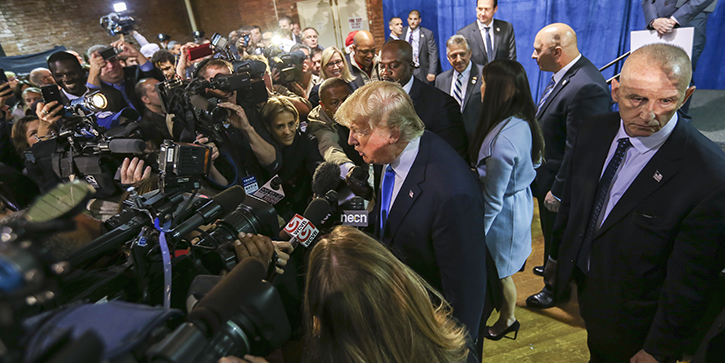
Globalist Job Slaughter: What Trump Voters and News Media Have in Common
-
 Patrick Watson
Patrick Watson
- |
- January 24, 2017
- |
- Comments
First, in the last two decades, new technology and globalist “free trade” agreements combined to destroy millions of middle-class jobs, particularly manufacturing jobs.
Second, our political and business elites either didn’t recognize this was happening—or just didn’t care. In either case, they failed to respond adequately as John Q. Public suffered. President Trump is a direct result of their negligence.
Some blame news media bias and “fake news” for the populist fever. Trump himself regularly attacks the media. They sometimes deserve it, too.
But when we look at the bigger picture, Trump supporters and journalists ought to be on the same side. Both are victims of the same broader forces.

Photo: Getty Images
“Objective” News Is a Myth
Long before Trump ran for office, I thought the news media should drop its façade of objectivity because there really is no such thing as “neutral coverage.”
The working reporters I know personally do their best to explain the news fully and fairly. They really want to get the essential facts right.
But every decision to prioritize one topic over another is an editorial judgment, deciding what the reader or viewer should and shouldn’t know. That decision can be wrong—and very often is.
Like what you're reading?
Get this free newsletter in your inbox regularly on Tuesdays! Read our privacy policy here.
Plus, every storyteller has a unique viewpoint. The words or images chosen always slant the story.
Since bias is inevitable, media outlets and individual reporters should just drop the neutrality act and let the public decide for itself how credible their coverage is.
That applies to both political and financial news. Investors rely on the media when making critical decisions about their money, so they need to know the difference between facts and opinion.

Photo: Getty Images
Pointing at the Wrong People
Last summer, I went to a Trump rally in Austin, Texas. I saw the little penned-off press area, which by that point had become kind of famous. It was smaller than I expected. Maybe 20 reporters sat in there during the rally, pecking away on laptop computers. A few people taunted them, but it was mostly peaceful.
The reporters at the rally were not the familiar faces from TV. I didn’t see any lattes or cheese trays or $1,000 suits. That’s because being in that pen was the media equivalent of working on an assembly line. Covering campaigns is hard, grueling work.
So, it was both ironic and a little unfair for Trump to point at the press pen and talk about how dishonest “those people” were. The editorial decisions Trump dislikes came from executives in New York and Washington, not the working stiffs he vilified.
Media Jobs Meltdown
Here’s a headline from last summer you might have missed…

… and here’s the story’s lead.
Washington (AFP) - The US newspaper industry has shed more than half its jobs since 1990, losses which have only been partly offset by gains in online media.
Official US Labor Department data showed the newspaper sector lost 271,800 jobs in the period from January 1990 to March 2016, or 59.7 percent of the total over the past 26 years.
The numbers, first cited in a report by the news website Engadget, confirm the massive shift to digital media that has hammered traditional newspapers.
Magazines fared only slightly better, losing 36 percent of their jobs in the same period.
Technology and globalization didn’t just kill manufacturing jobs. Print publishing went through a similar catastrophe. The newspaper and magazine industry was never as big, of course, so the numbers look small in comparison. But unemployment feels the same no matter what kind of work you did.
Yes, some new jobs appeared in digital media, but not for everyone.
Like what you're reading?
Get this free newsletter in your inbox regularly on Tuesdays! Read our privacy policy here.
Online news sites don’t need paper carriers and press operators—who, by the way, are part of “the media” but have nothing to do with slanting content one way or the other.
Stressed-out manufacturing workers and stressed-out media workers are both victims of the same economic forces, and both feel similar pain.

Photo: Getty Images
Megatrends Don’t Discriminate
The economic forces that brought us here don’t care who you voted for, or whether you voted at all. They have hurt workers in both the media and manufacturing industries:
- Technology automated their work.
- Consumer preferences changed.
- Overseas competition hit profit margins.
- CEOs stopped caring about workers.
The point is, American workers all face the same problems. And as I wrote two weeks ago, we’re all going to be “low-skilled” compared to artificial intelligence technology.
AI systems already write some online news stories, like game recaps and earnings reports. Those cookie-cutter topics are easily automated, but AI is improving quickly. As it does, many in the working-class media will lose their jobs. They know it, and they are scared too.
Bickering over minor disputes helps no one. The media should ask the Trump administration how it will address the important economic issues, and the White House should give plausible answers.
Once that happens, we’ll be on the way to solving our problems.
See you at the top,

Patrick Watson
Like what you're reading?
Get this free newsletter in your inbox regularly on Tuesdays! Read our privacy policy here.
P.S. If you’re reading this because someone shared it with you, click here to get your own free Connecting the Dots subscription. You can also follow me on Twitter: @PatrickW.
P.S. If you like my letters, you’ll love reading Over My Shoulder with serious economic analysis from my global network, at a surprisingly affordable price. Click here to learn more.

 Patrick Watson
Patrick Watson
